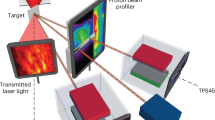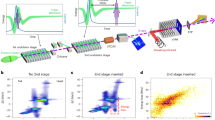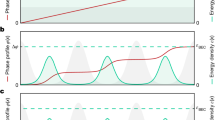Abstract
The theory1 that electron–positron pairs in magnetospheres of pulsars are created by the interaction of γ-quanta with the magnetic field B is the basis of the modern theory of pulsars2,3. When considering the process γ+B→e++e−+B in pulsars it is usually accepted that the γ-quanta produced by the curvature irradiation of the primary particles are emitted tangentially to the curved line of force of magnetic field and propagate directly. As they do so the pitch angle between the photon wave vector K and the magnetic field B increases until a certain value ψ1 when the absorption of the photon through pair creation becomes possible. We emphasize here that if the resonant behaviour characteristic of the vacuum polarization in a magnetic field4,5 is considered this picture changes considerably. Namely, the trajectories of γ-quanta are strongly bent towards the direction of the magnetic field if the latter is sufficiently intense and at the same time the creation is suppressed. We also discuss the effect this may have on the energy yield of pulsars.
This is a preview of subscription content, access via your institution
Access options
Subscribe to this journal
Receive 51 print issues and online access
$199.00 per year
only $3.90 per issue
Buy this article
- Purchase on Springer Link
- Instant access to full article PDF
Prices may be subject to local taxes which are calculated during checkout
Similar content being viewed by others
References
Sturrock, P. Astrophys. J. 164, 529 (1971).
Ruderman, M. & Sutherland, P. Astrophys. J. 196, 51 (1975).
Arons, J. & Scharlemann, E. T. Astrophys. J. 231, 854 (1979).
Shabad, A. E. Nuovo Cim. Lett. 3, 457 (1972).
Shabad, A. E. Ann. Phys. N.Y. 90, 166 (1975).
Erber, T. Rev. Mod. Phys. 38, 626 (1966).
Batalin, I. A. & Shabad, A. E. Zh. Eksp. Teor. Fiz. 60, 894 (1971); Soviet Phys. JETP 33, 483 (1971).
Agranovitch, V. M. & Ginzburg, V. L. Optics of Crystals with the Spatial Dispersion Taken into Account and the Theory of Excitons (Nauka, Moscow, 1979).
Tademaru, E. Astrophys. J. 183, 625 (1973).
Machabeli, G. Z. & Usov, V. V. Soviet Astro. Lett. 5, 238 (1979).
Lominadze, J. G., Machabeli, G. Z. & Usov, V. V. Astrophys. J. (in the press).
Author information
Authors and Affiliations
Rights and permissions
About this article
Cite this article
Shabad, A., Usov, V. γ-Quanta capture by magnetic field and pair creation suppression in pulsars. Nature 295, 215–217 (1982). https://doi.org/10.1038/295215a0
Received:
Accepted:
Issue Date:
DOI: https://doi.org/10.1038/295215a0
This article is cited by
-
Millisecond pulsars with extremely strong magnetic fields as a cosmological source of γ-ray bursts
Nature (1992)
-
Gamma-ray emission from pulsars
Journal of Astrophysics and Astronomy (1992)
-
The effect of photon capture and field ionisation on high magnetic field pulsars
Astrophysics and Space Science (1988)
-
Photon capture in pulsar magnetic fields
Astrophysics and Space Science (1987)
-
?-Rays from Her X-1
Astrophysics and Space Science (1986)
Comments
By submitting a comment you agree to abide by our Terms and Community Guidelines. If you find something abusive or that does not comply with our terms or guidelines please flag it as inappropriate.



